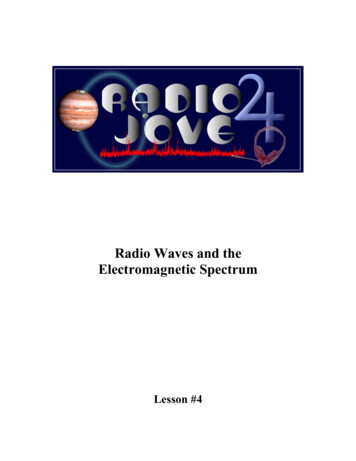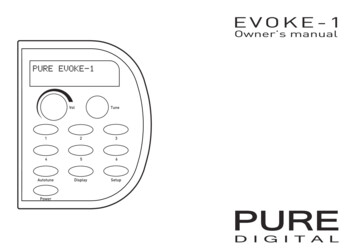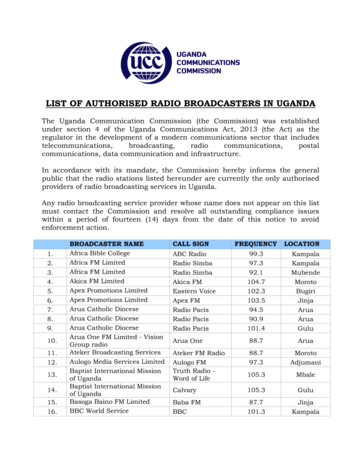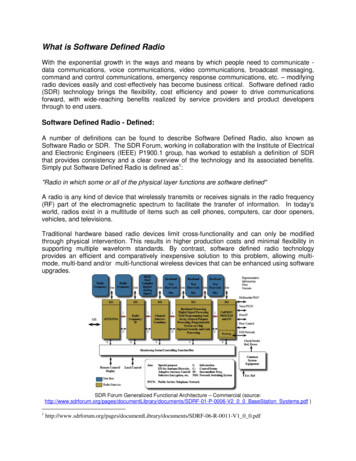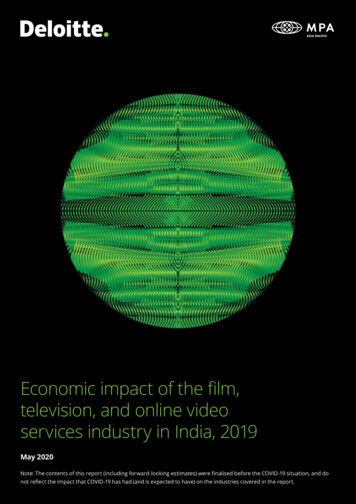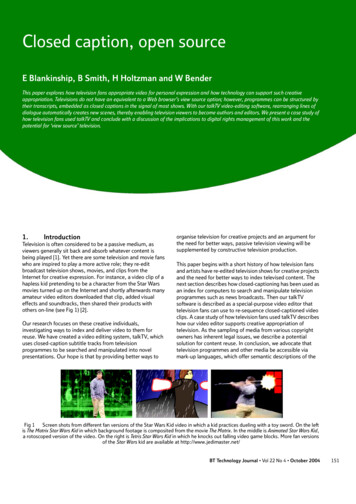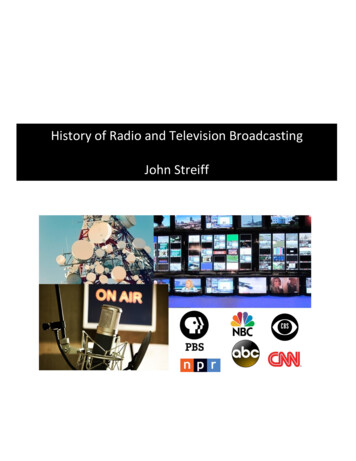
Transcription
History of Radio and Television BroadcastingJohn Streiff
History of Radio and Television Broadcasting – John Streiff – CWA 2018REFERENCESJump Cut! Memoirs of a Pioneer of Television by Arthur SchneiderThe History of Television, 1880 to 1941 by Albert AbramsonThe History of Television, 1942 to 2000 by Albert AbramsonWebsitesCalifornia Air Check at http://Californiaaircheck.comEyes of A Generation at http://eyesofageneration.com1
History of Radio and Television Broadcasting – John Streiff – CWA 2018OutlineClass focus is on Technology and InnovationsFormat : Capture, Storage and Distribution of Audio and VideoDay 1: Radio and Sound, Day 2: TV and Video, Day 3: Modern Radio/TVAudio Spectrum : 15 Hz to 20 KHzMicrophonesMicrophone Patterns- Unidirectional, Bidirectional, OmnidirectionalCarbon and Crystal Microphones300 Hz – 3.5 KHz limited but best for voiceTelco took advantage of limited bandwidth to avoid crosstalkUsed in PA, telephones and RadioDynamic Microphones200 Hz – 12 KHz best for voiceRugged, often used in TV since many were low profileUsed in PA, TV some in RadioRibbon Microphones50 Hz – 15 KHz wide bandwidth good for voice and musicRibbon quite delicated, easily fracturedUsed in Radio and TV studiosCondenser Microphones15 Hz – 20 KHz best bandwith for all purposesVery rugged despite being highly sensitiveUsed mainly in recording studios2
History of Radio and Television Broadcasting – John Streiff – CWA 2018Shotgun Dolly Boom mics20 Hz – 10 KHz often unidirectional mostly for TV voice pickupUsed in TV studios and field settingsFish pole boom used in TV and Film shoots especially in the fieldDolly used in studios for TV and FilmHandheld mics20 Hz – 10 KHz mainly for flexible voice pickupsOften used in TV game show applicationsLavalier mics20 Hz – 10 KHz mainly for voiceUsed in TV for variety shows and news broadcasters3
History of Radio and Television Broadcasting – John Streiff – CWA 2018Sound RecordingTranscription RecordingEarly Wax Cylinders and Disks used acoustic-mechanical lathesElectrified microphones made amplification possibleSound recording mastering of records and programsTranscription Applications in RadioProgramsCommercialsMusicMovie Sound StorageEarly film sound recorded opticallyTransitioned to magnetic film for productionContinued using optical sound into late 20th centuryMagnetic Audio Tape RecordingMagnetophone Audio RecorderEarliest magnetic tape system invented in GermanyPurchased by Bing Crosby after WWIIPrototype for Ampex 300 first commercial audio recorderFirst audio tape produced in U.S.A. by 3M.Magnetic Audio TapeFormat: ¼ inch wide, 1.5 mil thickSpeeds: Broadcast: 7.5 ips, Sound Recording: 15 ipsDuplication speeds: 30 and 60 ips; later: 120 and 240 ips4
History of Radio and Television Broadcasting – John Streiff – CWA 2018Ampex Tape RecordersMultitrack RecordingRequired by sound recording reduce multiple generations16 tracks on 2” tape, up to 32 with improved head technologyRadio Applications of Audio TapeProgramsCommercials, PSAs, PromosIDs, Beds and BumpersTape DelayCall In PackagesOff-Air Recording LogsTape LoopsSound beds and sound effects for RadioMacKenzie technology – similar to Laff Machine in TVCartridge tapeContinuous tape loop and automatically cued itselfPortable “sound in a box”Different sizes for spots, songs and programsTape Cartridge SystemsCartridge CarouselCartridge StackSchafer automationMusic on reel-to-reel tape; each cut cued opticallySpots, Ids and Time announcements on cartsMusic reel cuts could be played in random sequenceAudio sources could be played in various sequences5
History of Radio and Television Broadcasting – John Streiff – CWA 2018Radio Automation TodayModern Radio Automation is entirely software basedRuns on standard desktop computer systemsExamples: KWVF 102.7 Santa Rosa, Calif. & SiriusXM RadioVoxProBased on IBM PCReplaced reel-to-reel audio tape for call-in packagesUser interface similar to tape control interfaceLast reason to have reel-to-reel audio tape in DJ control boothsGently introduced Radio DJs and Program Directors to computers6
History of Radio and Television Broadcasting – John Streiff – CWA 2018Radio TransmissionFrequency SpectrumRadio TransmissionAM Spectrum 538 – 1700 KHz, Channel spacing 10 KHzFM Spectrum 88 – 108 MHz, Channel spacing 200 KHzFM Maximum deviation: 150 KHzAM TransmissionFM TransmissionEarly Radio NetworkingRadio Bicycle NetworksPrograms recorded on Transcription for non-connected affiliatesContinued by NER and NPR until 1980s.Regional Radio networksEarliest radio networks were regionalNBC Blue and Red – Live only in the NortheastSeparate originations in the West from San FranciscoNBC Blue - NBC Gold; NBC Red - NBC OrangeTranscontinental Radio NetworksNetwork circuit from New York to San Francisco one wayNetwork circuit eventually made reversibleShared by NBC Red and Blue networksHollywood’s rise changed focus from San Francisco to HollywoodNBC Red network circuit to Los AngelesEventually two-way circuits only between LA and New York7
History of Radio and Television Broadcasting – John Streiff – CWA 2018Round-Robin NetworksA closed loop network with multiple transmission pointsUsually administered by Telco Long LinesSome networks controlled their own transmit points : NPR ex.Networking Impacts on Network ProductionsNetworks move to HollywoodNBC – Radio City West - TV - Color: Color City BurbankCBS – Don Lee Network (KHJ) - KNX - TV: Television CityABC – NBC Blue - ABC - TV: Prospect & Talmadge StudiosNBC Radio Networks 1939CBS Radio Network 1939Networking TechnologyTransmitting multiple programs multiple phone callsMultiplexing allowed multiple channels on same cable or carrierMultiple Carriers allowed multiple channel groups on same mediaMulti-Channel RF Transmission allowed channel groups on radioLong Line From Cable to MicrowaveOriginal circuits were repurposed voice grade cable bundlesBroadcast circuits later travelled with voice grade circuitsSignals later multiplexed on wide band cables insteadCables replaced by point-to-point terrestrial microwave towers8
History of Radio and Television Broadcasting – John Streiff – CWA 2018Satellite NetworkingGeosynchronous satellites are stationary platforms in spaceTransponders receive and transmit on specific frequenciesSatellite transmissions are point-to-point line of sightSatellite ApplicationsTV Field RemotesTV and Radio Networking Between Network CentersRadio Networking Direct to StationsSatellite Broadcasting Direct to Subscribers9
History of Radio and Television Broadcasting – John Streiff – CWA 2018TelevisionBeginnings of Television Networks and StationsEarly Television stations were experimentalEarly Television networks mainly live broadcastLive telecasts mostly East coast onlyNon-interconnected affiliates received recorded programsFirst TV Broadcast NBC 1928 Flying Spot Scanner: “Felix The Cat”First TV News Broadcast on NBC Feb 16, 1949 John Charles DaleyFirst Live Coast to Coast Telecast NBC 1951 President TrumanNTSC Video Format525 Lines, 2 Fields, 1 Frame, 30 Frames / SecondForeign 25 Frames/Second formats: PAL and SECAMVideo scanning tubesIconoscope – very low quality used only for a short timeImage orthicon – standard for studio and field work in 20th centuryVidicon – Film chain broadcast and Industrial video standardPlumbicon – Norelco competitor to Image Orthicon from RCARCA Black and White CamerasTK-15 early studio and field camera – tube based very hotTK-44 later transistorized camera – cooler and lighter weightTelecineVidicon cameras captured still slide and motion picture filmsHad to transfer 24 fps film to 30 fpm video10
History of Radio and Television Broadcasting – John Streiff – CWA 2018Color Wars : CBS Field Sequential SystemIncompatible with existing monochromeUsed a Mechanical color wheelRequired television sets requiredCBS proposed color broadcasts on UHF – failed marketingColor Wars : NBC Compatible Color SystemCompatible with existing monochromeUsed Multiple scanning tubesMore electronicsEased transition to colorNTSC Color videoColor Burst signal on each frame carries color informationMonochrome receivers ignore the color informationVectorscope used with Color Bar chart to align color camerasRCA TK42 Color CameraTransistor, second generation RCA Color cameraUsed 3 3 ½” Image Orthicon tubes.Synthesized monochrome signalRCA TK44 Color CameraThird generation RCA Color CameraUsed 3 ½” Image Orthicon tubes for Color and 1 for monochromeDedicated monochrome signal, higher resolutionColor camerasRCA, Norelco PC-70, later Sony HDC 8000Camera MountsPedastal mount for studio use, Tripod for field and studio use11
History of Radio and Television Broadcasting – John Streiff – CWA 2018Camera CranesDolly Boom crane inherited from motion picturesUsed often for studio audience shots and dramatic studio shootsCamera MiniaturizationRCA Walkie-Lookied introduced at 1958 Policitcal ConventionsImagawa Handi-Lookie Japanese competitorFirst examples of wireless portable analog video cameraLater RCA CCD-1 digital video broadcast camera late 1990sVideo RecordingKinescopeImpact of Kinescope Recording on FilmBy May 1949, television networks were using 250,000 feet of film everyweek in New York City alone.By 1954, TV networks were using more film on a weeklythan all the Hollywood studios put together.Kinescope Options16mm B&W Negative, 16mm B&W ReversalInexpensive compared to 35 mmFast turnaround as it was developed in-houseOptical Film Sound track vs Magnetic Film Sound track35mm Color, 16mm MonochromeFor color since 16mm stock conventionally low resolutionExpensive stock and longer development timeNBC Lenticular Kinescope SystemUsed special film to record color on black and white stock12
History of Radio and Television Broadcasting – John Streiff – CWA 2018Extra: The Edsel Show (CBS)Film Production for TVInitially an alternative to Video production“Multicam” technique for audience showsLater, CBS and ABC competed with Color FilmI Love Lucy ShowGunsmokeVideo Tape RecordingEarly Videotape: VERA at BBCTypical of longitudinal attempts recording video at high speedQuadrature Tranverse Video RecordingTape recorded transverse with heads rotating at 14,400 rpmTape speed a leisurely 15 ips, conserved tape stockTracks: Audio, Video, Cue Track and Control TrackIntended for Time Zone Tape Delay broadcastsEarly 2” Quad VTRsAmpex VR-1000A first commercial videotape machineFunded by Bing CrosbyCopied by RCA to produce their TRT-1A one year laterTube based systems, monochrome onlyLater 2” Quad VTRsAmpex VR-2000B, first transistorizes commercial videotapeTRT-70 RCA’s first transistorized videotape machineMonochrome and color13
History of Radio and Television Broadcasting – John Streiff – CWA 2018Time Zone Delayed BroadcastsTime Zone Delay broadcasts were the reason videotape was firstintroduced, very similar to Kinescope recordings.Bing Crosby’s motivations to support videotape developmentsimilar to his motives to support audio tape development.First Network VTR DelayCBS November 1956 “Douglas Edwards and the News”Early VTRs at NBC Burbank 1964By 1964 NBC Burbank had 4 Ampex VR1000As and 8 RCA TRT-1AsSarnoff wanted NBC to be the Color NetworkNBC engineers modified VTRs at Burbank for Color TVFirst Color VTRs in the world; others had to wait for manufacturersNBC Burbank Tape Delay Schedule supported daytime and nighttimeVideotape Cartridges similar to audio cartridge tape systems14
History of Radio and Television Broadcasting – John Streiff – CWA 2018Post ProductionEditing VideotapePhysical EditingUsed Smith Guillotine Videotape SplicerCutting video did not sync cut with audio trackInitially limited utilityVideotape Manual Kamikaze AssemblyPlayback machine transferred scenes to Assembly master tapeManual control of the edit led often led to disastersProgram AssemblyIdeal process: make edit decisions from a copy of the masterConform the picture master one edit decisions were madeConform the sound tracks to the picture masterNBC Double System EditingSimilar to motion picture editing processUsed master videotape as the “negative”Kinescope work print used to make cutting decisionsMagnetic sound track used to conform production audioVideotape master picture conformed after all editing decisionsAudio dubbed from mag track to video master after editingESG – Editing System Guide cue tracksUsed to sync videotape master, work print and magnetic soundLaugh In - NBCArtie Johnson segment idea from editor: Art SchneiderMajor scenes: Monologue, Blackouts, Party, Vignettes, WallOver 150 edits per show – usual in TV Variety shows was 50.15
History of Radio and Television Broadcasting – John Streiff – CWA 2018Videotape Editec AssemblyAmpex answer to Assembly editingAutomatically made Assembly edited using Cue Track cuesSMPTE TimecodeInvented by EEMCO, standardized by SMPTEUsed today in Sound recording, Motion Pictures and TelevisionTells you where you are on reel; time of day scene was shotTimecode EditingUses SMPTE timecode to locate scenes and takes on reelsPortable Videotape RecordingAMPEX VR3000 – 2” early portable videotape recordedHelical Scan VideotapeLess expensive, Reversible, Enabled Slow motion and Stop motionApplications: Editing and Electronic JournalismAmpex Helical VTR: AMPEX VPR-1 HelicalOther Helical Videotape SystemsVideo LaserdiscsExpensive ,Reversible, Slow motion, Stop motionApplications: Editing and ReplaysEarly Computerized Editing1971 CMX-600 Editor1976 Ampex EDM-11989 Avid Media Composer16
History of Radio and Television Broadcasting – John Streiff – CWA 2018TransmissionVideo Transmission Spectrum - TV Transmission Band ChannelsVHF Channels 2 – 6,54 – 88 MHzVHF Channels 7 – 13, 174 – 216 MHzUHF Channels 14 – 69, 470 – 806 MHzChannel Bandwidth: 6 MHzAudio Carrier offset: 1.25 MHz, Video Carrier offset: 5.75 MHzDistributionMicrowave Terrestrial TV NetworkingSatellite Cable TV NetworkingSatellite TV Networking Direct to StationsPublic Media Interconnect TimelineSatellite TV Networking Direct to StationsSatellite TV Networking Direct to StationsPublic Media V5 and V6 InterconnectsNew PBS Interconnection RolloutRetain 2 of 3 existing satellite transponders : East &WestRetire 1 satellite transponder for offline playout.Later, move East and West live feeds to terrestrial fiber opticSignificant reduction to ongoing satellite costs17
History of Radio and Television Broadcasting – John Streiff – CWA 2018Digital Media ImpactsTechnology DriversAs the 20th century moves into the 21st century, the trends ofMiniaturization and Computerization continue to influence and drivenew technology for media.The most significant trend is the introduction of Digital Media, enabledby technology innovations in computer technology.The need for a common exchange mechanism for audio and videodrove new digital formats. Those formats in turn made possibleseamless media technology content integration across diverseplatforms.Digital MediaAnalog vs DigitalAnalog media differs from Digital media in a variety of ways.The most fundamental difference is in how the two represent the inputsignals, whether sound or light.Analog media makes copies of the input signal. Each time an analogsystem creates a new generation of an audio or video signal, the newcopy contains everything in all previous generations. This means thatany distortion or noise inherited from prior generations propagates tothe new generations. The result is that the quality of the analog signaldegenerates as more generations are created.Analog media signals are stored and transmitted as a continuous rangeof values. Every possible amplitude and phase of every possiblefrequency in the required bandwidth of the audio or video signal mustbe available at all times. This is more than is required, but it is a very18
History of Radio and Television Broadcasting – John Streiff – CWA 2018simple way to store and transmit signals. The result is that there mustalways be sufficient bandwidth to accommodate any signal at any time.Digital media works by creating a digital description of the input signal,whether audio or video. This digital description contains only sufficientinformation to recreate the audio or video signal on demand whenrequired. Since the description is digital in nature, it is stored andconveyed as binary digits or “bits”. The descriptions can therefore takeon only specific values for any given input signal. And it is possible toperform mathematical error checking on the digital descriptions todetermine if anything was lost in storage or transmission. This enableserror correction capabilities not available in analog media.Digital ArtAnalog media can only be altered by making some form of copy of anoriginal signal. To alter analog sound, the original sound must be passedthrough a device that changes the sound in some way and thenrecorded as a new copy on analog audio media. To alter analog video,the original video must be put through a device that alters the videoand then recorded as a new copy on analog video media.Since digital signals are stored as digital data descriptions, it is possibleto alter those descriptions directly if desired. Such changes to the digitaldescriptions will affect how those descriptions are rendered when thedigital descriptions are decoded back to analog sound or video forlisteners or viewers respectively.Digital audio and video editing is accomplished by altering the digitaldata descriptions of original audio and video signals.Digital CaptureFor the most part, microphones remain analog devices. The challengeof translating sound pressure waves to electrical signals is still an analogprocess.19
History of Radio and Television Broadcasting – John Streiff – CWA 2018Cameras produce digital outputs directly in the digital video world.Most cameras use CCD technology that produces digital signals directly.The signals must be encoded to digital format before it can beprocessed, stored or transmitted. This is accomplished by digitalencoder technology both for audio and video.Digital StorageThe sound and video recording industry today uses mostly hard diskstorage technology, similar to that found in computer systems. Themove is more to Solid State Device (SSD) technology with no movingparts, high reliability and long-term persistence.While SSD and similar technologies afford good long term storagesolutions compared to tape and film, archival storage for decades stilldemands etched solutions like CDs and DVDs.These solutions are used consistently in sound recording, motionpicture production and radio and television production.Digital DistributionInternet technology has been, without doubt, the key driver of late 20thcentury and 21st century media distribution.The sound recording, motion picture, radio and television broadcastingindustries have all uniformly moved to multiple tiers of Internet baseddigital media technology.Sound recordings are now available as digital audio streams. Radiosound is now likewise available as real time digital audio streams.Motion pictures are now distributed as digital video streams as aretelevision programs.20
History of Radio and Television Broadcasting – John Streiff – CWA 2018All digital media, whether distributed on disk media or on networkedmedia, contain mixed-media content. It is common for sound recordingsto be provided with text liner notes and images. Radio and televisionbroadcasts contain extra embedded information about the broadcasts.Motion picture disk and networked media streams often contain extrascenes, interviews with production team and cast members and otherbonus content. All of this is possible because of the extra capacityafforded by digital media technology.Digital ProductionShooting Format of Top 100 U.S. FilmsIn the past few decades, there has been a decided shift in the waytheatrical motion pictures are captured. In earlier years most everytheatrical motion picture was shot on film. Rarely was video capturecontemplated much less used in motion picture production.In more recent years, most all theatrical production shoots are done onhigh-definition video. The use of film as th primary shooting stock hasalmost completely vanished. Some motion picture directors ofphotography still use film to obtain specific visual looks and feels. Butevolving production techniques and digital video manipulationcapabilities are rendering almost all use of film stock unnecessary.Furthermore, digital video offers new types of special effects that aresimply not possible with analog motion picture film stock. Limitations oftraditional motion picture printing process special effects have beencompletely bypassed by modern digital video effects systems, which inturn obviate the use of digital technology over traditional film.21
History of Radio and Television Broadcasting – John Streiff – CWA 2018Video FormatsStandard definition formats were 4:3 aspect ratios.Standard definition format required that motion picture frames had tobe rephotographed to capture the effective working area of each framesince original motion picture frames had much larger aspect ratios thanstandard definition television frames could accomdate. This had theimpact of altering the visual scene as envisioned by the motion picturefilm director.High definition formats are various and extensible.Motion picture frames can be displayed directly on dynamicallyadjustable digital video and film frames can be compressed dynamicallyas well, thus removing the need for making scene-altering decisions andthus preserving the intentions of motion picture directors.CCD Video CaptureModern Charge-Coupled Device (CCD) technology enables directcapture and conversion of light to electronic digital signals. The face ofthe CCD is photo-sensitive, similar to a photographic emulsion.The main difference is that the CCD face is composed of millions ofpixels that are sensitive to various fundamental colors of light.These can be addressed directly on the CCD chip, which eliminates theneed to scan the photosensitive surface, unlike the traditional electronscanning beams in traditional video cameras and monitors.Production Special Effects EvolutionMotion Picture Glass MatteOne of the earliest techniques for shooting a synthetic scene in motionpictures was Glass Matte photography. A larger, often quite difficult tobuild, scene was painted on glass with space left through which a liveaction scene could be shot by a film camera. The resulting cameranegative was a composite shot that could be developed directly.22
History of Radio and Television Broadcasting – John Streiff – CWA 2018The main issue with this form of matte photography was that nochanges could be made to the scene once it was photographed.The next major innovation in matte photography was the introductionof a blackened area where the clear glass had been. This left the cameranegative clear in the blackened areas. The live action was photographedthrough a glass matte with all the painted areas in the original mattepainting blacked out. When the two rolls of footage were combined inthe printer, the composite scene rendered the final effect. The majoradvantage of this dual matte technique was that the matte paintingcould be produced after the live action photography had beencompleted.The glass matte technique was not restricted to films of yesteryear,although the technique is less often used in the 21st century. Two wellknown example are the “Star Wars” films and “Raiders of the Lost Ark”.Process PhotographyMotion Picture process photography involved putting live action in frontof a projection screen upon which another scene was rear projected.This technique required a specially equipped sound stage. The camerashutter photographing the live action scene in front of the screen hadto be shutter synchronized with the rear screen projector shutter.This was originally accomplished with a mechanical linkage between thecamera and the projector and required special stage construction.Most action films of the late 20th century used process photographyincluding the “James Bond” films. Perhaps one of the most famous filmsof the mid-20th century that used process photography was Hitchcock’s“North by Northwest”, starring Cary Grant.23
History of Radio and Television Broadcasting – John Streiff – CWA 2018In time, directors wanted a more flexible way to shoot process shots.With the advent of color photography, it became possible to use aspecifically colored background to insert background scenes duringprinting. The area inserted was governed by the parts of the original liveaction frame that did not contain the background color. Thus it waspossible to have dynamically changing background scenes and frames.Typically blue screens were used in motion picture production for thispurpose.The concept of blue screen process photography found its way totelevision in the analog media through ChromaKey technology.The technology took advantage of the way in which different colors areprocessed in video chains. This made it possible to add backgrounds tolive action or studio shots. The most typical example in the early analogvideo days were backgrounds in local and network news casts andweather reports.The introduction of digital video made it possible to extend backgroundcapabilities in a variety of ways. An early approach simply used theChromaKey concept, identifying those areas of a digital scene framethat contained a particular color. But the capabilities extended evenfurther, since it was possible to identify dynamically changing areas indigital video frames as background “layers”.The concept of layering had been introduced in analog video as Chyrontechnology, usually used to layer text over live action shots.Now with digital video multiple layers could be introduced either in liveproduction or in post-production or both.One of the most interesting capabilities today used in both televisionand motion picture production is the Digital Studio. The entire “SuzeOrman Show” was produced in a studio that is almost entirely paintedgreen. Every detail of the set and the backgrounds are digitally24
History of Radio and Television Broadcasting – John Streiff – CWA 2018generated. There are no physical sets of any kind. Only the liveperformers are not digital. Once the initial cost of building andequipping the digital studio is recovered, this is one of the leastexpensive ways of shooting video.It is used today both in television and in theatrical motion pictureproduction.Local TV uses digital layers extensively. The earliest examples appearedin Asian television. The technology made its way across Europe andEngland in the late 1980s and ‘90s and found its way to the U.S. in theearly 20th century. One of the first cable channels to use the technologywas Bloomberg News cable television. Today it is used by most everytelevision outlet, whether broadcast, cable or Internet.Digital Cinema TodayPerhaps one of the most dramatic, and for many lay people surprising,change is in theatrical film production and distribution. As noted,almost all motion picture production toady is shot on video originals.Virtually no film stock is shot any more.But the motion picture theater technology has also changed. Not onlyare motion pictures not shot on film, but they are likewise notdistributed on film either. Today almost all major theatrical motionpictures are distributed on digital video media. Delivery to theaters isprincipally via Internet technology. Modern motion pictures are filetransferred to theaters, stored on digital disk technology and projectedby laser-powered electronic projectors. There are no film reelsanywhere.25
History of Radio and Television Broadcasting – John Streiff – CWA 2018TV Digital CaptureHubcastingAlso known as “Central Casting”, Hubcasting is a new approach torunning local television and radio stations.Traditionally, television stations had studios with production controlrooms where local programs were produced. They had a separate“master control” where programs were put on the local broadcast air.Even when there was no one else at the station, there was always atminimum a master control operator loading film or videotapes, andswitching the on-air video and audio sources.However, Internet and new high-speed communications technologyinfrastructures offer a new more cost-effective way to manage thetraditional master control operations at the local station level.In a hubcasting scenario, all station content originates from the hubfacility which is often located in another city and state. The signal is sentvia satellite, microwave relay or fiber optic relay to the local station forlocal broadcast. The transmitter has to be in the local coverage area fortechnical reasons. The hub facility also sends the same signal to cableproviders and streams video to the Internet if desired. Only live to airprogramming actually originates at the station. All promos, localcommercial (even those shot at the local studio facilities) and allprerecorded local programs (like the Hampton Roads Show on WAVY)are sent by Internet or other relay link to the hub facility for broadcast.So when you are watching a hub station, you are actually watching asignal that originates from somewhere else in the country usually.26
History of Radio and Television Broadcasting – John Streiff – CWA 2018We are fortunate in the Williamsburg market to have examples of allthe major Hubcasting options in use today.The following table shows various local area TV stations, the channel(s)they broadcast on, their network affiliations and their companies ofownership.Local HubcastingWTKR3CBS HUB Tribune BroadcastingWGNT 7 CW WTKR Tribune BroadcastingWAVY 10 NBC NexStarWVEC 13 ABC No hubWHRO 15 PBS Public MediaWVBT 43 FOX NexStarWTKR is a local CBS affiliate, acts as a hub for Tribune Broadcasting. It isthe only station in the local market that does so.
History of Radio and Television Broadcasting – John Streiff – CWA 2018 13 Extra: The Edsel Show (S) Film Production for TV Initially an alternative to Video production “Multicam” technique for audience shows Later, S and A competed with olor Film I Love Lucy Show Gunsmoke
